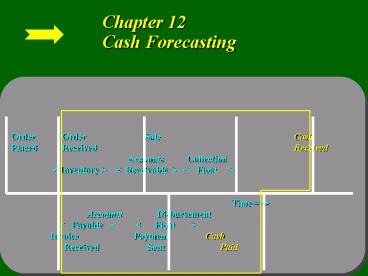Chapter 12 Cash Forecasting PowerPoint PPT Presentation
1 / 20
Title: Chapter 12 Cash Forecasting
1
Chapter 12Cash Forecasting
Order Order Sale
Cash Placed Received
Received
Accounts Collection lt
Inventory gt lt Receivable gt lt Float
gt
Time gt Accounts Disbursement
lt Payable gt lt
Float gt Invoice
Payment Cash
Received Sent
Paid
2
Objectives of Cash Forecasting
- Liquidity Management
- Financial Control
- Strategic Objectives
- Capital Budgeting
- Cost Management
- Currency Exposure
3
Steps in the Cash Forecasting Process
- Step 1
- Forecast Horizon and Intervals
- Step 2
- Variable Identification
- Step 3
- Modeling the Cash Flow Sequence
- Step 4
- Model Estimation
- Step 5
- Model Audit
4
Short-Term Forecasting Horizon
- Daily or weekly forecast for a period of up to a
month. - Aids in cash concentration transfers, funding
disbursement accounts, and making short-term
borrowing and investment decisions. - Helps in setting and managing balances used for
bank compensation.
5
Medium-Term Forecasting Horizon
- Also referred to as cash budgets.
- Forecast for 1 to 12 months.
- Used to determine the need for short-term credit
or availability of funds for short-term
investments. - Can be used as a benchmark of performance by
comparing actual cash flows to forecast cash
flows.
6
Long-Term Forecasting Horizon
- Forecast covers any period beyond one year.
- Are strategic forecasts used in long-term
financial planning. - Used by financial institutions and rating
agencies for credit analysis and evaluation.
7
Forecasting Philosophy
- Number and type of forecasts
- Expenditure on forecasts
- External versus internal forecasts
- Quantitative versus judgmental forecasting
8
Degree of Certainty
- Certain Flows
- Predictable Flows
- Less Predictable Flows
9
Data Identification
- Sources
- Identification
- Account Structure
- Reporting Requirements
- Historical Data
10
Forecast Method Selection
- Establishing Data Relationships
- Selecting a Method
- Testing Relationships
- Managing the Costs of Forecast Systems and Data
11
Forecasting Methods
- Methods for Short-Term Forecasting
- Receipts and disbursement forecast
- Distribution forecast
- Modified accrual
- Methods for Medium- and Long-Term Forecasting
- Pro forma statement
- Adjusted net income
12
Statistical Tools
- Causal methods
- Regression
- Time-series methods
- Moving average
- Exponential smoothing
- Time-series regression
- Model estimation
- Model audit
13
Forecasting MethodsReceipt and Disbursement
- Receipt Schedule
- Disbursement Schedule
- Both schedules are prepared on a cash basis.
- Completed forecast indicates the projected
deficiency or surplus of funds in relations to a
companys minimum cash requirement.
14
Forecasting Methods Distribution Forecast
- The total estimated cash flow is spread over the
days in the forecast horizon using proportions
that are using actual historical patterns. - Easy and inexpensive to prepare.
- Allows the incorporation of seasonality and
trends. - Large data requirements for proportion estimation.
15
Forecasting Methods Pro Forma Statements
- Based on the percentage-of-sales method.
- Requires a sales forecast.
- Determine balance sheet and income statement
items that can be assumed to be a constant
percentage of sales. - Assume other balance sheet and income statement
items are constant or can be updated based on
available information.
16
Pro Forma Statements (continued)
- Generate projected balance sheet and income
statements. - If projected assets are greater than projected
liabilities and equity, there is a projected cash
shortage. - If projected assets are less than projected
liabilities and equity, there is a projected cash
surplus.
17
Statistical Forecasting Time Series Forecasting
- Simple Moving Average
- Gives equal weight to past observations
- Will always lag any trend in actual cash flow.
- Approach can be useful in identifying cycles and
patterns of past data but does not take these
patterns into account in the forecast
18
Time Series (continued)
- Exponential Smoothing
- Allows the cash flow forecast to be adjusted by
the prior period forecast error. - Allows for more weight to be placed on the most
recent actual cash flows by choosing a smoothing
constant close to 1. - Forecaster must select the smoothing constant.
- Simplest version of the technique will lag trends
in the data.
19
Forecast Validation
- In-Sample Validation
- Out-of-Sample Validation
- Ongoing Validation
20
Summary
- The chapter began with a discussion of the
philosophy and environment within which cash
forecasts are made - The value of forecasts is to borrow less or
extend investment maturities - The five steps of forecasting were developed and
two major time intervals were presented - Forecast models were divided in two categories
causal and time-series - We discussed daily forecasting in the context of
the distribution method

